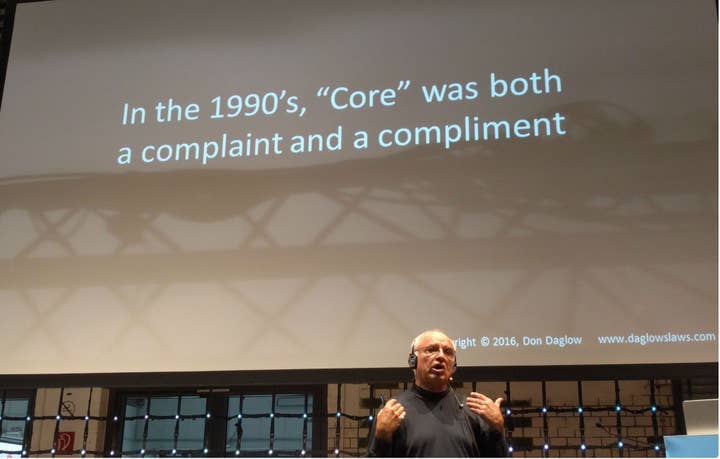Don Daglow: "I'm calling bullshit on core, mid-core and casual"
Veteran developer believes restrictive marketing language stems from industry's outdated veneration of difficulty
Veteran game designer Don Daglow used the stage at Berlin's Quo Vadis conference to mark an end to the use of three familiar but insidiously restrictive terms: core, mid-core, and casual.
Daglow illustrated his point with a slide depicting three animals: an elephant, a horse, and a mouse. Which of these animals, Daglow asked the somewhat bemused audience, most resembles a cat? The crowd's silence was deafening, but it was also expected.
"Lots of games are not like core, lots of games are not like mid-core, and lots of games are not like casual," Daglow said. "But we keep on trying to force them into these terms, and then we can't discuss our own craft. That's why I'm calling bullshit on, 'core, mid-core and casual.' We need to find other ways to talk about our games. We need to open up the discussion beyond our three animals."
"We keep on trying to force the games into these terms, and then we can't discuss our own craft"
Daglow's career as a game designer stretches back to the early Seventies, and he worked in prominent roles at some of the industry's pioneering companies. He was director of game development for the Intellivision at Mattel in 1980, for example, and joined EA a year after its foundation. However, at a time when the industry's products have never been so diverse, the language used to describe its audience is as restrictive and reductive as at any point in his career.
Specifically, the hard line between "core" and "casual" players was drawn around a decade ago, when the emergence of the Wii, the iPhone and social games presented a challenge to the fundamental assumptions on which the entire world of game development was based. By the era of PlayStation 2 and Xbox, publishers could, "predict what games would sell. You could sell large numbers of games for the first time. You could have series and franchises that would sell year after year. People who were trained in the business [at that time] were being trained in this stable world order.
"We went from peace and security, where we felt we knew what was going to happen, and we transitioned to this period where suddenly we didn't feel that way... We weren't used to seeing games with those characteristics be hits."
The most fundamental of the assumptions undermined by those new platforms - an assumption that, Daglow said, goes back to, "the very roots of game design" - is that all games should be difficult. For those accustomed to making games under that way of thinking, "what makes a game a game - the fact that it is a challenge - was under attack." In fact, Daglow said, the need to satiate a "core" audience with challenging games had been problematic for the industry for more than a decade.

"We would sit at lunch - and this went on for years - and say, 'Here's the problem we have: the magazine reviewers, who had so much influence on gamers, are very expert players, and they want very challenging games. Our own teams are expert players who want to make challenging games. The people in retail want very challenging games. And the first 100,000 people who will buy a game on a console want very challenging games.' So when the people who control your economic success, and your first customers, all want very challenging games, you'd better give them those games.
"But there was a problem. You'd sell your first 100,000 copies to those faithful players, yes, but as the Nineties went on, 100,000 copies was not enough to keep your job... If you made the game challenging enough to please the first 100,000 people, it meant you couldn't get to 1 million." But if you made a game too accessible, it wouldn't get enough support from the (at that time) all-powerful games media to sway the die-hard fans. "It felt like a trap," Daglow said, one that motivated publishers to start experimenting more than ever with partitioning games into difficulty levels.
"We get to the point where we are so preoccupied with the issue of difficulty that we stop talking about everything else"
It also prompted publishers to alter the language they used to describe the audience, switching from "hardcore" to just "core" when the "hard" part was no longer considered a desirable message. "Because core sounds very friendly... Core sounds very reassuring. Core sounds like you're going for the centre." By the time the Wii, Facebook and the iPhone emerged less than a decade later, Daglow said, the ensuing debate around casual games altered the perception of what "core" meant. "The term 'core' began to mean, 'Dammit, you're not going to take away our games.'
"The way we talk about core and casual [now] refers to only one thing: difficulty. We get to the point where we are so preoccupied with the issue of difficulty that we stop talking about everything else. We end up classifying our audience by the difficulty of the games they want to play."
This division, Daglow said, has always been a simplification, regardless of which words are used to describe the opposing sides. The games industry has grown far beyond the size and scope of the Nineties, and yet its products are still frequently grouped under terms that originate from that era - and only applied to a relatively small number of very skilled players even then.
Rather than propose new terms to replace core, mid-core and casual, though, Daglow simply asked the audience to consider new ways of thinking about their audience, and the often personal nature of their experiences. When he meets people that love games he worked on in the past, he said, "Never do they tell you about the graduation of play mechanics between the first and the second hour. I've never had that comment, or anything like it. But they will say where they were in their lives, both geographically and the age they were; who they were playing it with; and why it was so important that they still remember, that they still care. That 'Why?' always matters... We're trying to create not just a thought, but a feeling.
"We have to give that room [to the player]. We have to create that environment, instead of us telling our players why they play. That's the part we have to leave for them... It is not only our objective, but our obligation as artists. Sometimes the words get in the way of doing that very important work."
GamesIndustry.biz is a media partner for the Quo Vadis conference. Our travel and accommodation costs were provided by the organiser.

